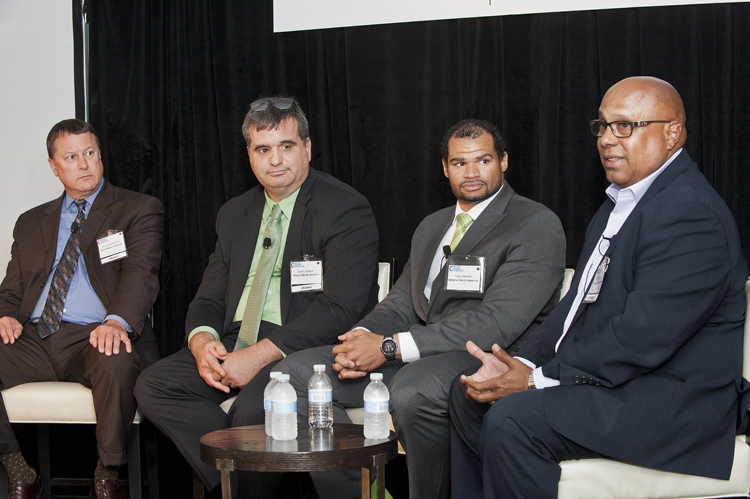
Speakers at the 2015 Import Export North American conference in Baltimore pointed to the need to improve visibility in the international vehicle logistics chain, and to work closely together ahead of what could be major changes to import and export patterns. Christopher Ludwig and Rachael Hogg report from Baltimore
Growth in the US new vehicle market has continued to push up volume and shipping activity for finished vehicle logistics in and out of the country’s seaports, including rising deep sea imports, trade with Mexico and global exports of locally built vehicles – particularly larger SUVs and trucks. Carmakers including BMW, Ford and Nissan have increased their port processing and shipping services; Honda now exports more vehicles from North America than it does from Japan.
Signs of this growth were discussed by executives from carmakers and ports at the Import Export North America 2015 conference in Baltimore. Jerry Schoenle, director of Ford Trading Company, which is responsible for deep-sea vehicle logistics, port activities and order processes at Ford, said that the carmaker’s global deep sea volume grow from 220,000 units to 600,000 over the past ten years. By 2020, Schoenle said this volume would grow to 1m units, including more exports from the US, such as the Lincoln brand to China and exports of the new Ford Mustang, as well as rising imports to the US from other global production locations, such as Spain, where Ford builds the latest version of its Transit Connect van.
Click the links for more news stories from the Import Export North America conference in Baltimore:
Tony Abrams, vehicle distribution centre (VDC) facility manager at BMW of North America, said that the German carmaker would open its newest VDC in Galveston, Texas by early next year to handle the growth in the region and to reduce long-distance trucking from the south-east. “That will be a strategic port that will support more cost efficient and quality distribution to the huge Texas market,” he said.
BMW is building a new plant in Mexico, which will begin production in 2019. Furthermore, Abrams said that the carmaker is considering adding another port on the west coast, possibly northern California. “Our west coast import volumes have grown, and the port of Hueneme [in southern California] is close to capacity,” he said.
Both Nissan and Honda, meanwhile, have increased short-sea imports into the US from Mexico, and are seeing growth in exports. Scott Pollard, manager of vehicle logistics for Nissan North America, revealed that the carmaker is now shipping about 70,000 vehicles a year from Veracruz to the east coast ports of Jacksonville, Baltimore and Newark.
The overall outlook for the North American ocean trade in finished vehicles is somewhat uncertain, however. While the US continues to see growth in the import of vehicles built outside North America this year, the import share relative to domestic production is declining. Brandon Mason, senior analyst for the Americas at PwC Autofacts, predicted that more than 80% of the added production volume in the US and Mexico over the next five years would be for regional consumption, and is likely to take a direct bite out of the volume of imported volume – perhaps as much as 50% by 2021.
For some ports, this shift might mean that volume originally coming from Japan, South Korea or Germany will now arrive from Mexico. However, rail remains the dominant transport mode for shipping vehicles northbound from Mexico; furthermore, the 2m units of additional production forecasted for the US are expected to stay mostly regional, which overall could have a seismic impact on shipping lines and port processors.
"We know that ports are increasingly congested and we know if we don’t do something now, we will be negatively impacted as to how the products we need everyday are shipped." - Paul 'Chip' Jaenichen, USDOT
Speakers also revealed that logistics services at ports have experienced setbacks in productivity, as a lack of investment and rising freight volumes cause congestion at many ports. Rail-related delays for inland connection, and a high number of safety and quality holds on vehicles – partly as a reaction to major recalls – have lead to bottlenecks.
Kurt Nagle, president and chief executive officer at the American Association of Port Authorities (AAPA), which represents ports across the western hemisphere, pointed to a significant lag in federal investment in ports, which would typically cover areas such as port depth and width, compared to private companies and local port authorities.
“We just completed a ‘state of freight’ report, and found that congestion is on the rise at landside connectors,” said Nagle. “Just in the last ten years, congestion has increased by 25% or more. That is hurting productivity – one in three of our members say that this has hurt productivity by at least 25%.
“The investment needs are rising, with 75% of our members saying they require $10m or more in their landside connectors; one in three needs $100m in intermodal upgrades.”
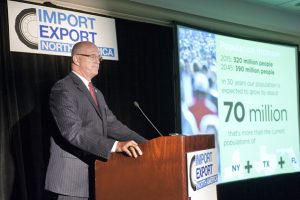
Paul Jaenichen, maritime administrator at the US Department of Transportation (DoT), expressed worry about investments in infrastructure, particularly in the face of long-term expectations for population and freight growth. “We’re concerned about where ports are,” he said. “We know that they are increasingly congested and we know if we don’t do something now, we will be negatively impacted as to how the products we need everyday are shipped.”
Road bumps ahead
The economic picture for the US and North American market this year remains largely positive. Brandon Mason predicted that US new light vehicle sales would rise to more than 17m units (up from 16.4m in 2014), marking the sixth consecutive year of growth. Meanwhile, North American light vehicle production is expected to grow to 17.5m units in 2015 (up from 17.1m last year).
However, Mason predicted that US sales were likely to approach their peak this year, and remain fairly stable through 2021. He pointed to a rise in interest rates by the Federal Reserve that could begin as early as this autumn, which would start to push up rates for automotive loans. PwC estimates that if the Fed were to move the central bank interest rate up from near 0% today, where it has been since 2009, towards ‘normal’ rates of around 3-4%, the typical automotive loan interest rate would move from an average of 4.3% today to around 7.75%.
“That rate would take a lot of people out of the market, especially as new vehicle purchases are already limited to the upper quintile of the population,” said Mason.
PwC expects that the US will see a cyclical downturn sometime later in this decade, which the auditing firm currently predicts for 2018, when sales may dip back to 16.4m units. “Any downturn is expected to be fairly brief, as the US economy is much better positioned to weather trouble today than before the financial crisis,” said Mason. By 2021, he predicted US sales would be back to around 17.2m.
Canadian sales are forecasted to grow mildly from 1.8m units last year to 2m by 2021; Mexico is forecasted to grow strongly from a low base, increasing by 35% between 2014 and 2021 to 1.5m units.
Even if sales growth may be subdued, the rise of North American vehicle production is expected to rise unabated for the rest of the decade, reaching 20m units by 2020, the first time the region would have crossed this threshold. The US is forecasted to expand production from 11.5m in 2014 to 13.5m units in 2021, while Mexico will grow from 3.2m to 4.8m light vehicles. PwC forecasts that Canada, by contrast, will see one or two assembly plants close, losing more than 500,000 units of production over that period, from 2.4m to 1.9m units.
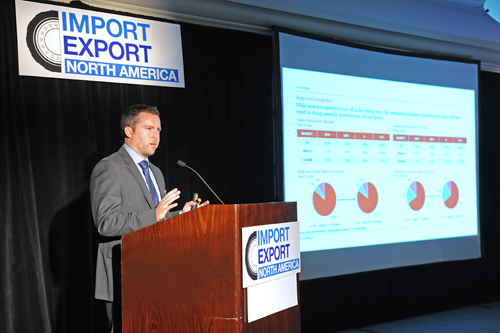
This shift could potentially take a significant bite out of non-NAFTA imports. Signs of such decline are not yet entirely evident: in 2014, imports from outside North America to the US reached 3.5m units and are currently on pace to stay similar or increase slightly to 3.6m. This number would be close to the high of 3.8m imports in 2007 and up substantially from 2.7m units in 2009. Of that current total, around 90% of vehicles came from Japan (1.62m in 2014), South Korea (748,000) and Germany (739,000). The four largest importers of vehicles to the US – Toyota, Hyundai-Kia, Subaru and Mazda – all increased the number of vehicles they shipped to the US in 2014.
However, the import share versus domestic production has been falling, dropping from a peak of 26.5% of sales in 2009, to around 21% this year. Some declines are already evident at a number of carmakers. Nissan, for example, saw non-NAFTA imports to the US fall by more than 20% last year to 279,400, even as its overall sales grew 11%. Honda, which has been the most aggressive to localise its production in North America, saw its US imports from outside NAFTA fall by 57% to 37,700 last year.
All of the major importers have plans for US or Mexican plants, and PwC’s analysis suggests that the lion’s share of the new production volume will be for regional and especially US consumption. For example, Toyota is planning to add 200,000 units in a new plant in Mexico, and a further 281,000 units from expanding existing North American plants – Mason said that 100% of this additional volume is expected to stay in North America. A 200,000-unit expansion for Subaru at its Indiana plant is also expected to produce 100% for North America. The joint venture plant in Aguascalientes between Mercedes-Benz and Infiniti is expected to build 90% of its eventual 300,000-unit capacity for North America. BMW, which is increasing production by 250,000 between expanding its South Carolina plant and adding a facility in Mexico, is expected to keep 80% of this volume in North America.
Some plants, such as Volkswagen Group’s new Audi plant in Mexico or Daimler’s use of contract manufacturer AM General to build the R-Class for China, will have a higher proportion of export production.
Overall, however, Mason predicted that out of 2.65m units of expanded capacity expected between now and 2021 across the region, 84% (2.23m) would stay in North America, including 1.85m units for the US. Given that overall sales are expected to be relatively stagnant, he suggested that this number could lead to a drop of up to 50% for vehicle imports coming by deep sea. The impact for vehicle logistics would be sizeable, including shifts in transport for rail distribution within the US and Canada, as well as rail and short-sea flows out of Mexico.
There are of course exceptions and wild cards within the PwC prediction. Should the Fed decide to delay an interest rate rise for whatever reason, “the brakes could come off on vehicle sales growth”, at least for the short term, said Mason.
"We’ve seen huge swings in currency, including 40% on either side for currencies like the yen, yuan, won and euro... many carmakers and tier suppliers are choosing to take that out of the equation by building more in North America." - Brandon Mason, PwC Autofacts
Likewise, far-reaching (but also long delayed) trade deals with Pacific Rim countries and with the European Union could have further impacts on trade flows. There is even potential for a production location such as China to gain market share in the US. Technically this has already started on a small scale with the import of a long wheelbase version of the Volvo S60 from China. Mason pointed to the potential for Ford to use China as an export base for models such as the Taurus, an entirely new version of which is being launched in China, while GM also has tentative plans to export China-built Buicks to the US. Currency devaluation, combined with a slowdown in China could encourage carmakers to make use of spare capacity for export.
However, Mason predicts that China will recover strongly, adding another 9m units of production and domestic sales by 2021; the prospect of substantial exports to North America anytime soon seem remote.
Some carmakers also continue to make moves towards increasing exports to the US. Jerry Schoenle said that Ford plans to increase its import of vehicles into the US, including for the latest Transit Connect van from Spain, 50,000 of which are expected this year. The fall in the Japanese yen and the euro, meanwhile, could encourage some carmakers to allocate more production for the US. Nissan has added production of the Nissan Rouge in Japan and South Korea for export to the US to compliment North American production.
However, Mason suggested that most carmakers would continue to neutralise foreign exchange fluctuations by localising their production. “We’ve seen huge swings in currency, including 40% on either side for currencies like the yen, yuan, won and euro,” he said. “It is hard to plan around that, so many carmakers and tier suppliers are choosing to take that out of the equation by building more in North America.”

Should imports really be heading for a fall, vehicle-handling ports may expect some relief exports, which Mason predicted would grow at a steady level in the coming years. For US production, this growth is likely to be driven by sales of SUVs and trucks, aided by the low price of oil. Mason pointed in particular to Fiat Chrysler plants building Jeep products in Michigan and Ohio, GM’s plant at Arlington, Texas, for trucks and SUVs, BMW’s X family of SUVs in Spartanburg, and Mercedes-Benz’s plant in Alabama, which builds GL Class SUVs, all of which export beyond NAFTA.
Charles Franklin, manager of export logistics for American Honda – whose organisation is also responsible for non-NAFTA exports for Canada and Mexico – said that the carmaker had seen a strong rise in shipments as well. The H-RV model, which Honda builds at its plant in Celaya, Mexico – has just been launched in Europe, for example.
Scott Pollard, who is responsible for exports from the US for Nissan, said that the carmaker is now exporting to 68 countries, shipping more than 123,000 vehicles last year (with close to 50,000 going beyond Canada and Mexico). Shipments vary from a few dozen to some Latin American countries, to nearly 30,000 per year to the Middle East. “It makes the accuracy and visibility of transport more important. If you a miss a shipment to some countries, for example, they might lose their inventory for the month,” he said.
A need for sustainable funding
Though vehicle volumes through ports may be difficult to predict, a number of speakers emphasised the need for investment in North American ports if they are to keep up with long-term population and freight growth. Kurt Nagle, from AAPA, outlined the need for $29 billion across 100 projects by 2025 at US ports, including $6.9 billion for ports in the North Pacific, $6.5 billion for the South Pacific and $4.1 billion for Gulf ports.
“The needs far outweigh the levels of appropriations in that funding,” he said. “We are working with members of the administration because we vitally need to have dedicated and sustainable sources of funding. We already face a big challenge to keep the highway trust fund related programmes funded, and this investment in ports is in addition.”
Nagle pointed to the need for a national freight strategy for the US, something that Paul Jaenichen said the government and Maritime Administration are working on, including the establishment of funding and loan guarantees. One way that the federal government is directly supporting investment projects is through TIGER grants (Transportation Investment Generating Economic Recovery), which provides funds to invest in rail, transit and port projects.
Some of the funds have gone towards vehicle-handling ports, including a $10m grant to the Port of Baltimore in 2013, and $16m to the port of Los Angeles.
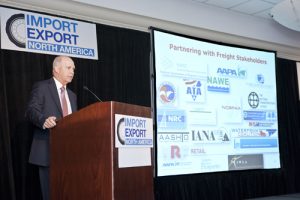
However, the TIGER programme is highly oversubscribed. The current funding round has around $500m in grants across all transport modes, with about 10% typically allocated to maritime projects. Jaenichen noted that the administration has received $9 billion in applications. “We can only give out a nickel for every dollar requested,” he said.
In the current Surface Transportation Bill, which has been passed by the Senate and now awaits a vote in the House of Representatives this autumn, investment in infrastructure is slated to increase by some 45%. TIGER funding would be allocated $1.2 billion, which could mean maritime funding of $125m. “But we know that this will not be enough, and that we have to work together with port authorities and private companies to meet demand,” Jaenichen said.
Along with Tiger, the government is developing other programmes and seeking to expand funding from other sources within the Transportation Bill, including through programmes that had previously been dedicated to highway or rail funding.
Some OEM executives noted that space constraints at port have impacted their operations. Tony Abrams from BMW said that port congestion was leading to inefficiencies, with trucking carriers needing more time to move vehicles after vessels arrived. Mexico is also a particular question mark, as Honda’s Charles Franklin noted the ports were getting more crowded.
Jerry Schoenle said that the move towards more exports in larger volume from the US was presenting some new challenges for the carmaker and its processors. “We’re coming from having done exports for a long time in small volumes. As numbers grow, we and our suppliers are coming to grips with what that means, such as adding more repair capability and extra shifts on processing,” he said. “We have to stay ahead of that, and make sure that we don’t create a choke point.”
Rick Powers, director of marketing for the Maryland Port Administration, which owns much of the land at the port of Baltimore, pointed to issues around dwell time that results from vessel bunching, as well as inconsistent volumes of vehicles and delays for inland transport.
“We have floated the idea for a long time of developing inland ports, where we move cargo to a position inland for handling,” he said. “I think it is an idea whose time has come, but nobody seems to want to talk about it.”
Problems beyond the port
Despite space issues, executives, including Charles Franklin, Scott Pollard and Tony Abrams, said that their services within US ports were mostly reliable and not highly impacted by insufficient draughts or berths. Rather, the infrastructure that has hurt operations the most has been inland connections, especially for rail.
“For Ford, our biggest congestion point is the connection outside the port – primarily rail – which we are seeing for both our imports and exports in multiple places,” said Jerry Schoenle.
Pollard also pointed to rail and road delays as an issue for Nissan both for imports and for exports. He pointed to a closure on a major interstate highway in Indiana because of an unsafe bridge, which led to a major detour for vehicles heading to Chicago. Franklin added that rail disruptions, especially during winter, were Honda’s biggest issue for moving exports.
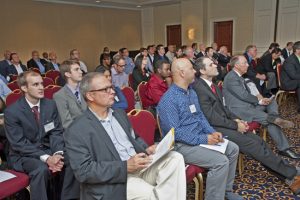
In many cases, executives said that congestion and bunching issues at ports were partially carmakers’ own making, whether because of uneven production and sales pushes at the end of the month or quarter, new vehicle launches, or holds on vehicles for quality and safety checks. The latter has always been a part of new model launches, but holds and checks appear to have increased following the spate of vehicle recalls.
“We see a proactive approach and pressure from Washington DC in terms of recalls, and thus more quality and safety checks,” said Tony Abrams at BMW. “We used to let the dealer fix a lot but now we tend to keep [imported vehicles] at the port and fix them here.”
Schoenle also said that Ford made every effort to address a quality hold at the port rather than with customers or in destination markets that might lack the proper repair and inspection centres. Nissan’s Pollard says that there has been a higher focus among engineers to make sure any problem is detected. “It sometimes means we are holding imports or exports at the port. But nobody wants to be the engineer that let a bad car go,” he said.
Hidden X factors
The theme of this year’s Import Export North America conference was ‘The Efficiency Equation: velocity + throughput + space’. The conference revealed that, while the coefficients of this equation are fairly simple, there is considerable complexity involved in all of these factors, whether linking back to plant production plans, rail and truck connections, or real estate.
Rick Powers, for example, highlighted how ports like Baltimore are constantly battling real estate developers who want to convert former industrial areas near the port into apartments or hotels, while the port believes much of this land can still be developed for shipping-related activity.
“Even the ugliest area at the port is still ‘waterside property’ and so interesting to developers,” he said. The port of Baltimore is part of a special initiative that has secured guarantees on major parts of the waterfront that will keep the sites zoned for industrial use through to 2024, and it is working to seek further guarantees until 2034.
"As [Ford exports] grow, we and our suppliers are coming to grips with what that means, such as adding more repair capability and extra shifts on processing. We have to stay ahead of that, and make sure that we don’t create a choke point." - Jerry Schoenle, Ford Trading Company
Scott Pollard added that no efficiency equation would be complete without also considering quality, cost, and labour. Meanwhile, he stressed the importance of considering all cost factors, including inventory-carrying cost. The “X factor” in Nissan’s import and export logistics is often cash flow, he said. “We look at what port we go to based on cash flow. Some of our Chinese and Korean exports go out of Georgia, for example. That’s counter-intuitive until you look at the cost flow, because it’s faster than going by rail and truck to California or west coast ports.”
Jerry Schoenle made a similar point for Ford. “There’s the physical flow and the financial flow. We realise we’ve got inventory hung up at different stages of the supply chain, and reducing that is the business case for a lot of work we’re doing.”
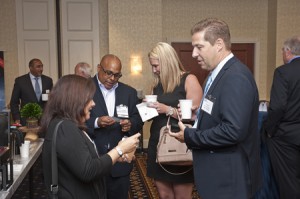
Speakers agreed that improving this cash and cargo flow would come with better visibility, a problem that continues to haunt all carmakers, whether through unreliable vessel arrivals, rail snarls or weather disruptions (or all of the above). Both Schoenle and Pollard agreed that they know where their vehicles are based on scans from ports, plants, distribution centres or rail yards, but that the deviation in lead times remains too wide to share that information openly with customers. To avoid disappointment, most carmakers therefore give dealers a notification about which week a vehicle will arrive, although the total accuracy of this ETA across an import/export chain is even more questionable.
Executives are looking into ways of improving this information. Schoenle believes that by improving Ford Trading Company’s interactions and information flow with plants, sales and logistics teams, great improvements will be made. Others, such as BMW, are even experimenting with the use of vehicle telematics that could eventually improve real time tracking.
Any technological or process improvement would depend upon close interactions between all supply chain partners in the import and export chain – and that collaboration is perhaps the most important, if less visible factor in the efficiency equation.
Import Export North America is the third Automotive Logistics conference this year covering North American topics, following Automotive Logistics Mexico in January and FVL North America in Newport Beach, California. The next event in the calander will be Automotive Logistics Global held September 22-24 at the Renaissance Center in Detroit.
Click here to see all of the Automotive Logistics conferences held around the world.

























![Global[1]](https://d3n5uof8vony13.cloudfront.net/Pictures/web/a/d/s/global1_726550.svgz)









